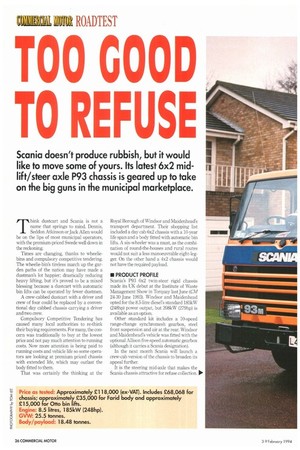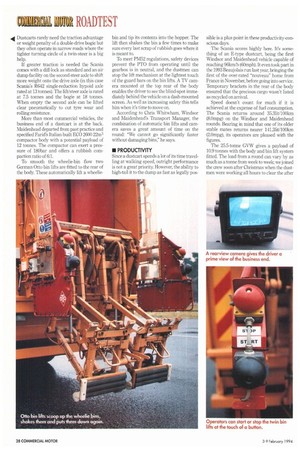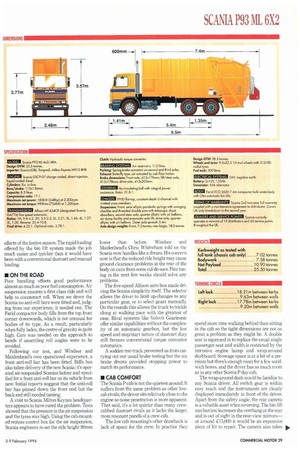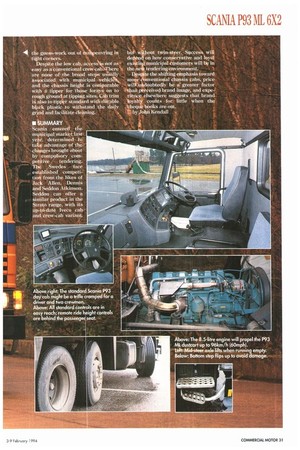TOO GOOD TO R FUS
Page 28

Page 30

Page 31

Page 33

If you've noticed an error in this article please click here to report it so we can fix it.
Scania doesn't produce rubbish, but it would like to move some of yours. Its latest 6x2 midlift/steer axle P93 chassis is geared up to take on the big guns in the municipal marketplace.
Tlunk dustcart and Scania is not a name that springs to mind. Dennis, Seddon Atkinson or Jack Allen would be on the lips of most municipal operators, with the premium-priced Swede well down in the reckoning,
Times are changing, thanks to wheeliebins and compulsory competitive tendering. The wheelie-bin's tireless march up the garden paths of the nation may have made a dustman's lot happier; drastically reducing heavy lifting, but it's proved to be a mixed blessing because a dustcart with automatic bin lifts can be operated by fewer dustmen.
A crew-cabbed dustcart with a driver and crew of four could be replaced by a conventional day cabbed chassis carrying a driver and two crew.
Compulsory Competitive Tendering has caused many local authorities to re-think their buying requirements. For many, the concern was traditionally to buy at the lowest price and not pay much attention to running costs. Now more attention is being paid to running costs and vehicle life so some operators are looking at premium priced chassis with extended life, which may outlast the body fitted to them.
That was certainly the thinking at the Royal Borough of Windsor and Maidenhead's transport department. Their shopping list included a day cab 6x2 chassis with a 10-year life span and a body fitted with automatic bin lifts. A six-wheeler was a must, as the combination of round-the-houses and rural routes would not suit a less manoeuvrable eight-legger. On the other hand a 4x2 chassis would not have the required payload • PRODUCT PROFILE Scania's P93 6x2 twin-steer rigid chassis made its UK debut at the Institute of Waste Management Show in Torquay last June (CM 24-30 June 1993). Windsor and Maidenhead opted for the 8.5-litre diesel's standard 185kW (248hp) power output, but 208kW (279hp) is available as an option.
Other standard kit includes a 10-speed range-change synchromesh gearbox, steel front suspension and air at the rear. Windsor and Maidenhead's vehicle was fitted with the optional Allison five-speed automatic gearbox (although it carries a Scania designation).
In the next month Scania will launch a crew-cab version of the chassis to broaden its appeal further.
It is the steering mid-axle that makes the Scania chassis attractive for refuse collection. Pi
44 Dustcarts rarely need the traction advantage or weight penalty of a double-drive bogie but they often operate in narrow roads where the tighter turning circle of a twin-steer is a big help.
If greater traction is needed the Scania comes with a diff-lock as standard and an air dump facility on the second steer axle to shift more weight onto the drive axle fin this case Scania's R642 single-reduction hypoid axle rated at 13 tonnes). The lift/steer axle is rated at 7.5 tonnes and the bogie at 18 tonnes. When empty the second axle can be lifted clear pneumatically to cut tyre wear and rolling resistance.
More than most commercial vehicles, the business end of a dustcart is at the back. Maidenhead departed from past practice and specified Farid's Italian-built ECO 2600 22m3 compactor body with a potential payload of 12 tonnes. The compactor can exert a pressure of 180bar and offers a rubbish compaction ratio of 6:1.
To smooth the wheelie-bin flow two German Otto bin lifts are fitted to the rear of the body. These automatically lift a wheelie bin and tip its contents into the hopper. The lift then shakes the bin a few times to make sure every last scrap of rubbish goes where it is meant to.
To meet PM52 regulations, safety devices prevent the vro from operating until the gearbox is in neutral, and the dustmen can stop the lift mechanism at the lightest touch of the guard bars on the bin lifts. A TV camera mounted at the top rear of the body enables the driver to see the blind-spot immediately behind the vehicle on a dash-mounted screen. As well as increasing safety this tells him when it's time to move on.
According to Chris Whitwham, Windsor and Maidenhead's Transport Manager, the combination of automatic bin lifts and camera saves a great amount of time on the round: "We cannot go significantly faster without damaging bins," he says.
• PRODUCTIVITY Since a dustcart spends a lot of its time travelling at walking speed, outright performance is not a great priority. However, the ability to high-tail it to the dump as fast as legally pos sible is a plus point in these productivity-conscious days.
The Scania scores highly here. It's something of an E-type dustcart, being the first Windsor and Maidenhead vehicle capable of reaching 96krnih (60mph). It even took part in the 1993 Beaujolais run last year, bringing the first of the over-rated "nouveau" home from France in November, before going into service. Temporary brackets in the rear of the body ensured that the precious cargo wasn't listed as recycled on arrival.
Speed doesn't count for much if it is achieved at the expense of fuel consumption. The Scania returns around 353141100km (8.0rripg) on the Windsor and Maidenhead rounds. Bearing in mind that one of its older stable mates returns nearer 141.31ft/100km (2.0mpg), its operators are pleased with the figures.
The 25.5-tonne GVW gives a payload of 10.9 tonnes with the body and bin lift system fitted, The load from a round can vary by as much as a tonne from week to week; we joined the crew soon after Christmas when the dustmen were working all hours to clear the after effects of the festive season. The rapid loading offered by the bin lift system made the job much easier and quicker than it would have been with a conventional dustcart and manual loading.
• ON THE ROAD Poor handling offsets good performance almost as much as poor fuel consumption. Air suspension ensures a first class ride and will help to counteract roll, When we drove the Scania no anti-roll bars were fitted and, judging from our experience, it needed one. The Farid compactor body fills from the top front corner downwards, which is not unusual for bodies of its type. As a result, particularly when fully laden, the centre of gravity is quite high. Care was needed on the approach to bends if unsettling roll angles were to be avoided.
Following our test, and Windsor and Maidenhead's own operational experience, a front anti-roll bar has been fitted. Biffa has also taken delivery of the new Scania: it's operated air-suspended Scanias before and specified for a front anti-roll bar on its vehicle from new. Initial reports suggest that the anti-roll bar has pinned down the front end but the back end still needed taming.
A visit to Scania Milton Keynes headquarters appears to have cured the problem. Tests showed that the pressure in the air suspension and the tyres was high. Using the cab-mounted remote control box for the air suspension, Scania engineers re-set the ride height 80mm lower than before. Windsor and Maidenhead's Chris Whitwham told us the Scania now handles like a dream. His concern now is that the reduced ride height may cause ground clearance problems at the rear of the body on exits from some cul-de-sacs. Fine tuning in the next few weeks should solve any problems.
The five-speed Allison auto box made driving the Scania simplicity itself. The selector allows the driver to limit up-changes to any particular gear, or to select gears manually. On the rounds this allows the truck to trickle along at walking pace with the greatest of ease. Rival systems like Volvo's Geartronic offer similar capabilities without the complexity of an automatic gearbox, but the low speed and stop/start nature of dustcart duty still favours conventional torque convertor automatics A sodden test-track prevented us from carrying out our usual brake testing but the six brake drums provided stopping power to match its performance.
• CAB COMFORT The Scania P-cab is not the quietest around. It suffers from the same problem as other lowcab rivals; the driver sits relatively close to the engine so noise penetration is more apparent. That said, it's a lot quieter than many crewcabbed dustcart rivals as it lacks the larger, more resonant panels of a crew-cab.
The low cab mounting's other drawback is lack of space for the crew In practice they spend more time walking behind than sitting in the cab so the tight dimensions are not as great a problem as they might be. A double seat is squeezed in to replace the usual single passenger seat and width is restricted by the intrusive engine hump and wrap-around dashboard. Stowage space is at a bit of a premium but there's enough room for a few sandwich boxes. and the driver has as much room as in any other Scania P day-cab.
The wrap-around dash would be familiar to any Scania driver. All switch gear is within easy reach and the instruments are clearly displayed immediately in front of the driver. Apart from the safety angle, the rear camera is a valuable asset when reversing. The bin-lift mechanism increases the overhang at the rear and is out of sight in the rear-view mirrors— at around £15,000 it would be an expensive piece of kit to repair. The camera also takes
4 the guess-work out of inApeuvring in tight corners.
Despite the low cab, access not as easy as a conventional crew eabli•There are none of the broad steps usirally associated with municipal vehicIN and the chassis height is coniparable with a tipper for those forays on to rough ground at tipping sites. Cab trim is also to tipper standard with durable black plastic to withstand the daily grind and facilitate cleaning.
• SUMMARY Scania entered the municipal market last yettr. determined to take advantage of the: changes brought about by compulsory com petitive tendering. The Swedes face established competition from the likes of rs" Jack Allen, Dennis and Seddon Atkinson. Seddon can offer a similar product in the Strato range, with its up-to-date Iveco cab and crew-cab variant, but wihout twin-steer. Success will depend. on how conservative and loyal existing municipal customers will be in theme* tendering environment. Despite the shifting emphasis toward mote i.onventional chassis cabs, price will undoubtedly be a' greater factor -'than perceived brand image, and experience elsewhere suggests that brand kkyaltr counts for little when the „theque books are out.
by,John Kendall




















































































